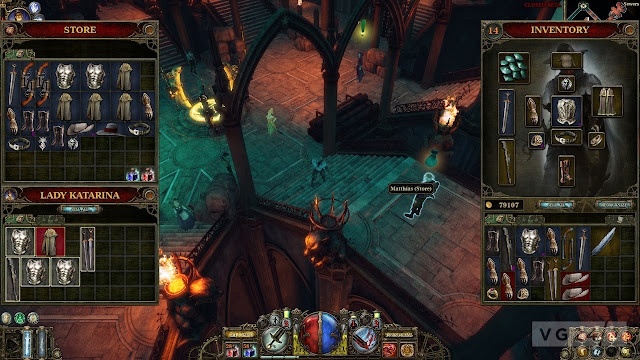Action-RPGs in the vein of Diablo or Torchlight are some of
the few games that I can infinitely enjoy, even if it brings nothing new to the
table. Perhaps it’s the lust for an endless loot grind, or maybe it’s simply my
fondness for stats and basic number-crunching. Van Helsing is definitely one of
those games for me. It may offer very little in the way of original ideas and
may suffer from some uneven design, but the core loot-driven experience is
still well intact here and the $15 price tag can easily make up for a lot of
the game’s rougher edges.
 |
| From the outset, the gameplay appears extremely familiar and standard, but there plenty of interesting concepts and quirks. |
Aside from the ability to freely activate one-time
“PowerUps” which give your next attack an added effect, such as increased
damage or an area of effect bonus, the game features nothing that makes it
really stand out from any other standard action-RPG/Diablo clone. Something
that should probably be noted right away, since Van Helsing is by no means a
game-changer and is very much a just competent and very standard ARPG. The core
gameplay is essentially a combination of everything that makes an ARPG of this
type work well. And if you’ve played any sort of hack ‘n’ slash-type game
you’ll know what to expect from Van Helsing’s hordes of monsters and array of disproportionate
Area-of-effect spells and abilities.
Van Helsing does make some attempt to venture outside the
norms of a well-worn genre, however, by not featuring any of the standard
classes you’d expect to see. Instead of being given a choice between some
obscure extension of a warrior or a mage, the game simply has a default
jack-of-all-trades template for you to specialise into a number of different
playstyles. The game’s “PowerUps” allow you to effectively combine keeping
enemies far away with slows and snares, and bunching them up and simply
clobbering them all together. It’s this freedom that allows Van Helsing to play
as dynamically as its rivals and competitors without following the standardised
Mage, Warrior, Rogue trope.
 |
| Loot. So much damn loot. |
The game also attempts, somewhat successfully, to have a
fairly distinctive art style and direction. The Flintlock weaponry, the spinning
cogs and rising pistons that fill the HUD and countless industrial environments
indicate a clear Steampunk-inspired visual style right. And yet this is quite
heavily contrasted with the Fantasy world of magic and mythical creatures. A
blend of Steampunk and Fantasy is an interesting (and potentially really cool)
combination and, although not entirely original, it would certainly help the
game stand out amongst others. It’s just a shame that it feels out of place
more often than it fits, but when it does work the combination of Steampunk and
fantasy can actually be quite compelling (see enormous industrial drill/giant
worm boss fight, for example). In most cases, it’s the enemy design that’s fun
and imaginative whereas the environmental design often lacks that same
creativity.
The game has a great visual style with some excellent art
direction and feels somewhat like a blend of the semi-realistic-looking art
direction of Diablo 3, and the Steampunk-vibe, creative monster design and fun
weapon design of Torchlight 2. The game has some pretty good sound design with
a decent soundtrack and voice acting of varying quality (Van Helsing and his
spectral companion sound pretty great, but the supporting cast sound a little
rough). And although some of the environments can leave a lot to be desired in
terms of design and originality, they do look quite excellent.
 |
| Dynamic skill trees and interchangeable weaponry allow for multiple play styles |
If you’re a fan of the genre, or just looking for a fun and
relatively quick co-op game, then Van Helsing is just the thing for you, but if
you’re looking for something fresh and more original then you might want to
look elsewhere. Van Helsing is neither really good nor really bad; for the most
part it’s just a serviceable and somewhat forgettable experience in places. And
the price of $15 is well worth the length and replayability the game has to
offer.











.jpg)








